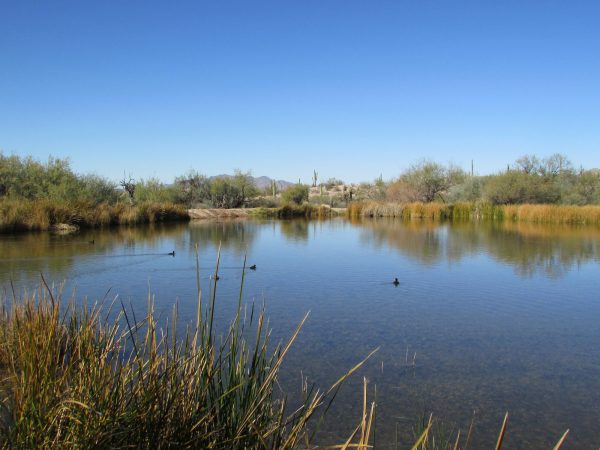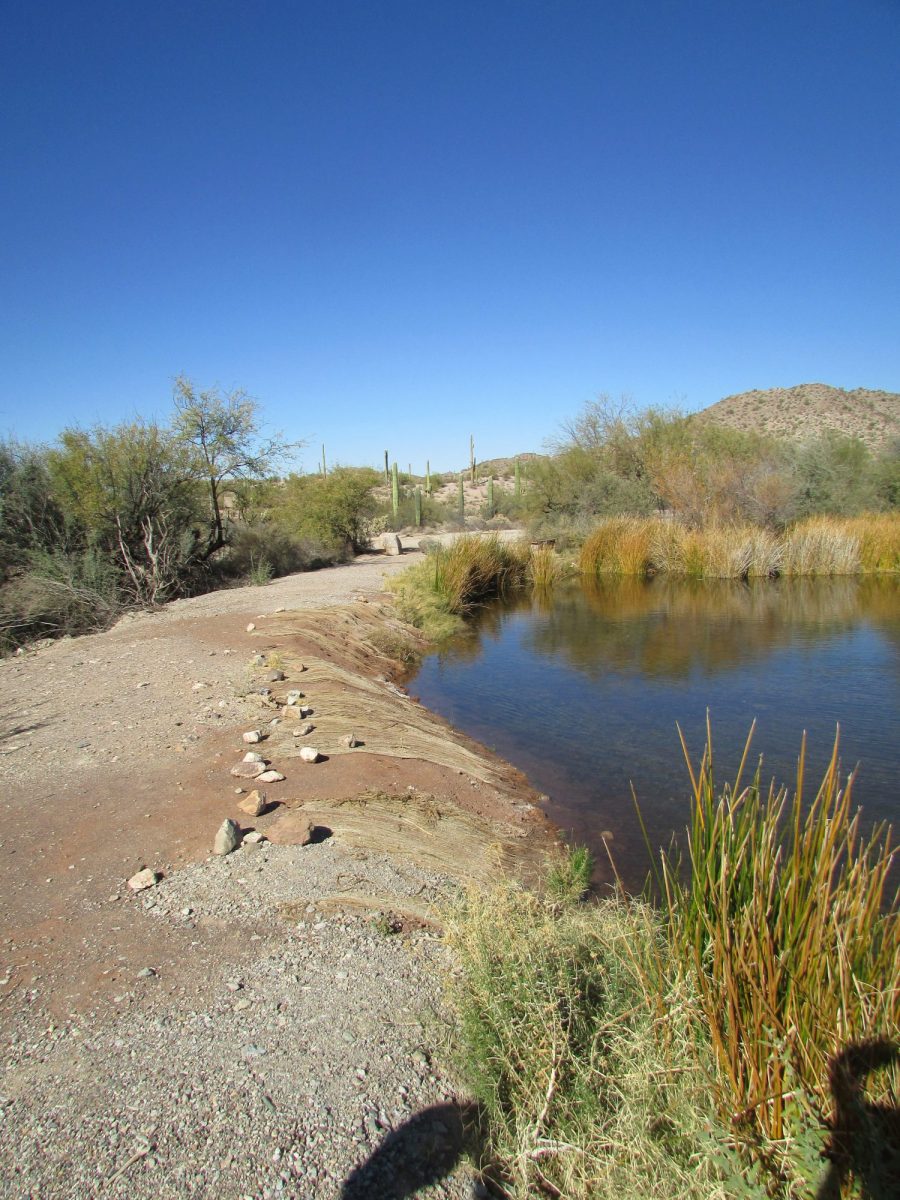
The pond at Quitobaquito is the only place in the United States where the endangered Sonoyta mud turtle, the caper butterfly and the Quitobaquito pupfish can be found naturally. Photo courtesy of Jared Orsi
On the border between Mexico and Arizona is the postage stamp-sized oasis of Quitobaquito. Natural springs feed a pond and support wildlife and lush vegetation.
But while the pond itself is tiny, what it holds is immense, said Jared Orsi, a professor in Colorado State University’s Department of History in the College of Liberal Arts, and director of its Public Lands History Center.
Part of the Organ Pipe Cactus National Monument, the pond at Quitobaquito is smaller than a football field but is the second largest year-round surface water in the Sonoran Desert, one that attracts a diverse wildlife. It is the only place in the United States where the endangered Sonoyta mud turtle, the caper butterfly and the Quitobaquito pupfish can be found naturally.
This oasis has also attracted humans to it for more than 12,000 years, said Orsi, who specializes in environmental and borderlands history.
But despite that fact, the National Park Service has historically managed it as if it were a wilderness area where people are largely absent, he said.
“The twist is that in the late 1950s and early 1960s, after having chased the Native peoples out of the park, the park service also then took a bulldozer and eliminated all physical evidence of their historic presence,” Orsi said.
Now both the NPS and Orsi are responding to efforts from Indigenous communities to bring that presence back into the light.
Recovering lost landscapes
The NPS bought out the last Native American family living there in the late 1950s in order to create the appearance that it was uninhabited. Recently, parks officials have begun working with Native peoples to try to improve Indigenous access to the springs, as well as to address the social and environmental challenges that threaten it today.
As part of that effort, in 2017 Orsi wrote an administrative history for the NPS regarding its relationship with Quitobaquito Springs. From that, he has since begun writing a book, Recovering Lost Landscapes: History and Memory at a Desert Oasis. Set to publish in 2023, the book is both a case study in human adaptation in a difficult environment, as well as a look at America’s longstanding history of denying the sovereignty, inventiveness, and persistence of the Indigenous populations.
“I’m trying to make visible worlds that have almost completely, but not totally, disappeared from the landscape,” Orsi said.

Each group that came to this land imagined a certain way of life, he said. The process of turning cultural aspirations into actual, physical places is something that all human beings do — from some of the earliest Indigenous stewards of the land, the Hia-Ced O’odham and the Tohono O’odham, to the colonial period when Spanish, Mexican, and U.S. newcomers migrated to the area.
“It’s a story of a co-created landscape, so unlike a lot of books about national parks, Indigenous people don’t disappear after the first chapter,” Orsi said. “In my book, they are central to the story all the way through. Native people and newcomers worked together to shape Quitobaquito into something else.”
The area around Quitobaquito was once a prehistoric trade route. On the Old Salt Trails, people used the route to acquire salt and other commodities from nearby Sonora, Mexico. In the 1860s, a dam was built that changed what had been a marsh into more of an actual pond. Later, irrigation ditches were built, and new crops were introduced.
It became a surprisingly multicultural landscape, Orsi noted, adding that the border at that time was very fluid, which led to collaboration.
Even the name Quitobaquito may be an example of this. While the exact origin of the name “Quitobaquito” is unknown, some scholars believe it is a merging of the Spanish and O’odham languages and means small spring or watering place. Others think it may derive from a ranching term meaning “Git, little calf.”

The arrival of the National Park Service
When the National Park Service reserved the land in 1937, the agency attempted to focus almost entirely on preserving and protecting the environment, to the exclusion of the people who had called it home and their history.
“I try to recover those landscapes,” Orsi said. “The way that people took their aspirations and tried to imprint them on the land at Quitobaquito, and also what it has meant for the National Park Service to manage a place that has such deep history and is so subject to change.”
Orsi said he finds that last part somewhat ironic. The overriding spirit of the NPS is preservation, preventing something from changing.
“And yet, there’s a lot that’s changing in this environment even now,” he said. “The geology and hydrology that allow for the springs to flow have changed greatly. The animal and plant populations have shifted, and climate change is starting to take a big toll on this place.”
The current climate of Quitobaquito
Over the past four decades, the water flow at Quitobaquito has steadily dropped. Nearby construction projects, including the border wall between the U.S. and Mexico, are believed by some to be exacerbating the problem.
In addition, the site has become a popular place for drug smugglers to attempt to cross into the U.S.
“How do you manage this little place that is being buffeted by international migration patterns, that’s gotten entangled in the war on drugs and border immigration issues, and climate change, and politicians’ aspirations in Washington?” he posited. “All of these things emanate from far outside of the park, well beyond what the Park Service is able to control. And yet these things are causing incredible flux for this tiny, postage stamp body of water.”
Now the NPS is working to preserve not only the environment of Quitobaquito Springs, but also its stories, Orsi said. A goal whose time has more than come.
“I think it’s important because this place tells a larger story of persistent ignoring and disregarding on the part of American culture of Native experience as an important constituent part of American society,” he said. “Long after the military conquests of Native lands that took place in the 18th and 19th centuries, it tells a story of Indigenous people consistently being pushed aside, ignored, undervalued by mainstream American culture, and I think that’s a story that is part of the nation’s heritage that needs to be understood.”
But it is also a story that is still ongoing.
Quitobaquito tells a remarkable story of cross-cultural collaboration, Orsi said. From the multicultural oasis that existed around the turn of the 20th century to the collaboration between the NPS and Native peoples over the last 20 years.
"It tells a story of Indigenous people consistently being pushed aside, ignored, undervalued by mainstream American culture, and I think that’s a story that is part of the nation’s heritage that needs to be understood."
“And while those collaborations have yet to come to full fruition, I think they give us a sense of how we can look to history for examples of things that worked and how we can try to implement them even further in the future,” he said. “I think both groups are on the verge of being able to collaborate to interpret the site in a way that honors tradition and also allows for environmental preservation.”
Navigating Borders
From water to dance, science to film, clay to gender, the liberal arts helps us navigate the borders in our lives that are physical, metaphorical, or cultural.
